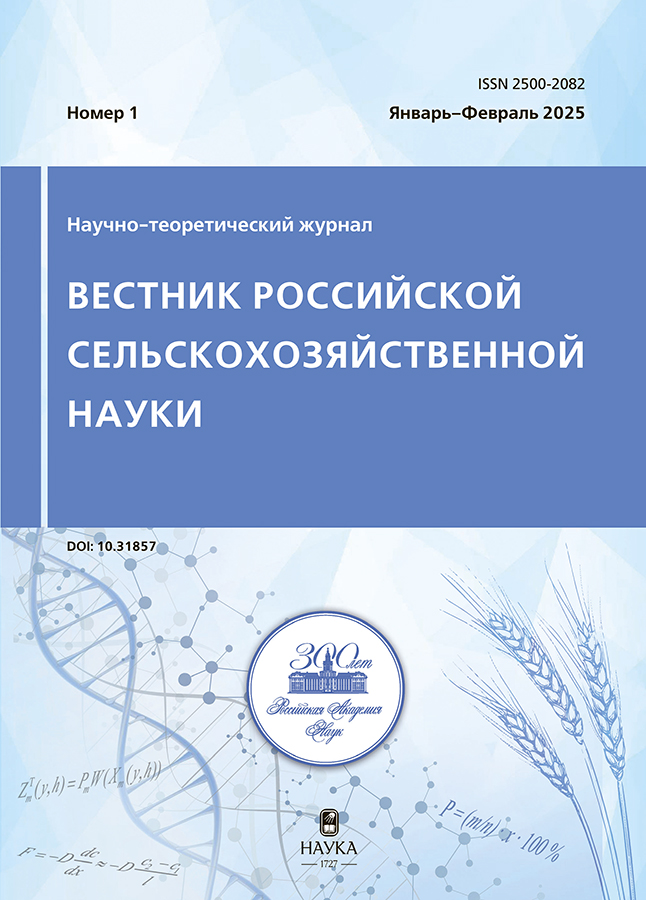Environmental factors influencing the spread of larval cestodosis of reinder in the YANAO
- Autores: Leshchev M.V.1, Gavrichkina A.A.1, Gavrichkin A.A.1
-
Afiliações:
- All-Russian Scientific Research Institute of Veterinary Entomology and Arachnology – Branch of Federal State Instution Federal Research Centre Tyumen Scientific Centre of Siberian Branch of the Russian Academy of Sciences
- Edição: Nº 1 (2025)
- Páginas: 51-54
- Seção: Zootechnics
- URL: https://archivog.com/2500-2082/article/view/686152
- DOI: https://doi.org/10.31857/S2500208225010116
- EDN: https://elibrary.ru/CSRNNG
- ID: 686152
Citar
Texto integral
Resumo
Reindeer husbandry is the basis of life, lifestyle and traditions of the aboriginal population of the Far North. As a result, the active development of the resources of Western Siberia reduces the areas suitable for reindeer grazing. Compaction of territories suitable for grazing animals creates conditions for the spread of infectious and invasive diseases that reduce productivity, weaken immunity, and often lead to the death of deer. Parasitic worms of the Cestoda class are the most numerous group in terms of the variety of pathogens of invasive etiology in reindeer. Larval cestodoses are found everywhere in reindeer herding farms in the Far North. The aim of the study was to study the infestation of reindeer with cysticercoses in the Yamalo-Nenets Autonomous Okrug in order to clarify the species diversity and intensity of the lesion. Cysticercoses are caused by the larval stages of cestodes and parasitize the internal organs and tissues of animals, sometimes humans, causing acute inflammatory processes of the organs. The main source of the spread of cysticercosis in deer are reindeer dogs, and wolves and arctic foxes also spread the invasion. Despite the significant contribution of scientists and veterinary specialists to the study of this issue, the treatment of cysticercosis has not been sufficiently studied. During the autopsy of reindeer at slaughter complexes and directly in the field, larvae of three species of the genus Taenia were found: T. hydatigena, T. krabbei, T. parenchimatosa. The prevalence of invasion of parenchymal cysticercosis averaged 33.4% in the district. Tarandular cysticercosis was less common with an extensive invasion of 23.7%. The incidence of teniuclear cysticercosis (EI) in the districts was 2.4%. There was a significant difference in the invasiveness of deer by different types of cysticerci depending on the sex and age group of deer.
Palavras-chave
Texto integral
Sobre autores
M. Leshchev
All-Russian Scientific Research Institute of Veterinary Entomology and Arachnology – Branch of Federal State Instution Federal Research Centre Tyumen Scientific Centre of Siberian Branch of the Russian Academy of Sciences
Autor responsável pela correspondência
Email: tamaraa111@mail.ru
PhD in Veterinary Sciences
Rússia, TyumenA. Gavrichkina
All-Russian Scientific Research Institute of Veterinary Entomology and Arachnology – Branch of Federal State Instution Federal Research Centre Tyumen Scientific Centre of Siberian Branch of the Russian Academy of Sciences
Email: tamaraa111@mail.ru
Junior Researcher
Rússia, TyumenA. Gavrichkin
All-Russian Scientific Research Institute of Veterinary Entomology and Arachnology – Branch of Federal State Instution Federal Research Centre Tyumen Scientific Centre of Siberian Branch of the Russian Academy of Sciences
Email: tamaraa111@mail.ru
PhD in Biological Sciences
Rússia, TyumenBibliografia
- Andreev A.A. Osobennosti rasprostraneniya gel'mintozov sredi zhitelej polyarnyh i pripolyarnyh rajonov //Mezhdunarodnyj studencheskij nauchnyj vestnik. 2021. № 2. S. 161–161.
- Kazanovskij E.S. Veterinarnoe blagopoluchie severnogo olenevodstva-vazhnyj rezerv sohrannosti pogolov'ya i uvelicheniya produktivnosti otrasli. Strategicheskie prioritety v upravlenii prirodnoresursnym potencialom evropejskogo severo-vostoka i zony arktiki. // Agrarnaya nauka Evro-Severo-Vostoka. 2017. № 4. S. 44–47.
- Kokolova L.M., Gavril'eva L.Yu. Cisticerkozy severnyh olenej v Yakutii // Nauka, tekhnika i obrazovanie. 2018. № 11 (52). S. 101–103.
- Leshchev M.V. Epizootologiya invazionnyh boleznej severnyh olenej v Yamalo-Neneckom avtonomnom okruge. Avtoref. dis. … kand. vet. nauk. 2008. S. 11–13.
- Mednova T.V. Issledovanie myasa oleniny na Kol’skom poluostrove // Nauka i sovremennost’. 2011. № 9-2. S. 35–39.
- Nikolaev S.V. Harakteristika gel’mintofauny severnyh olenej Bol’shezemel’skoj tundry //Agrarnaya nauka na sovremennom etape razvitiya severnyh i arkticheskih territorij. Sb. nauch. mat. Vseros. nauch. konf. s mezhd. uch., posvyashch. 90-letiyu Nar’yan-Marskoj sel’skohozyajstvennoj opytnoj stancii (1932-2022). Nar’yan-Mar, 2022. S. 28.
- Pel’gunov A.N., Maklakova L.P. Parazitologicheskie aspekty, svyazannye s akklimatizaciej i introdukciej dikih kopytnyh // Rossijskij parazitologicheskij zhurnal. 2013. № 3. S. 67–75.
- Pochepko R.A. i dr. Epizooticheskaya situaciya po cestodovoj invazii domashnih severnyh olenej v olenevodcheskih hozyajstvah Murmanskoj oblasti // Veterinariya segodnya. 2021. T. 1. № 1. S. 52–58.
- Yakimenko L.V., Ivanenko N.V. Arkticheskoe prirodopol’zovanie: novaya paradigma //Territoriya novyh vozmozhnostej. Vestnik Vladivostokskogo gosudarstvennogo universiteta ekonomiki i servisa. 2021. T. 13. № 2. S. 109–119.
Arquivos suplementares










